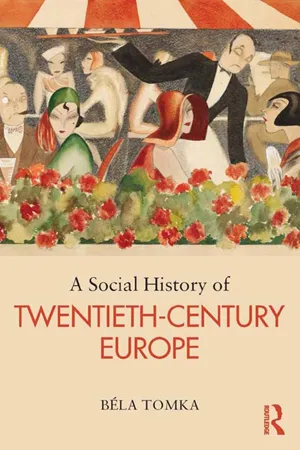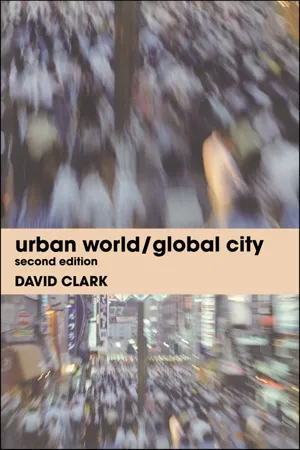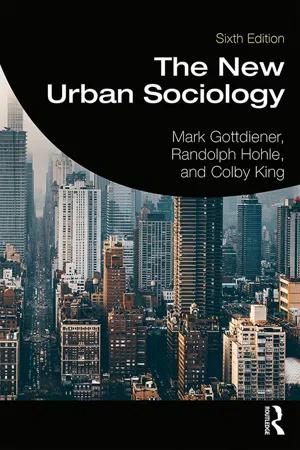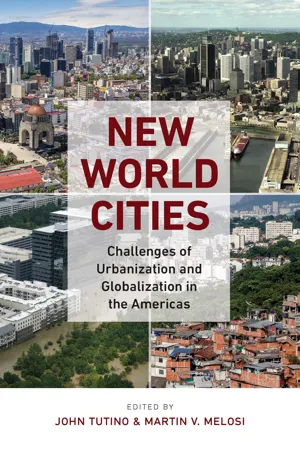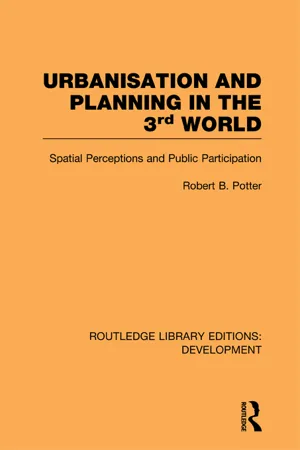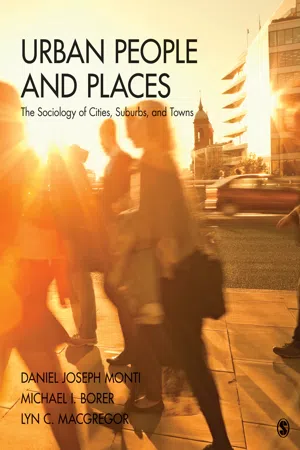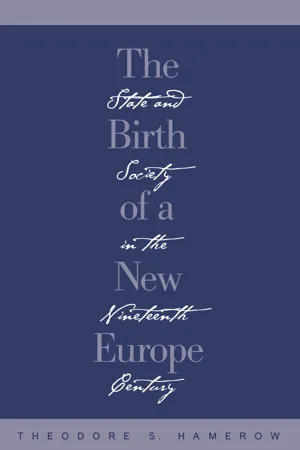History
Urbanisation in America
Urbanisation in America refers to the significant growth of cities and the migration of people from rural areas to urban centers. This process was fueled by industrialization, technological advancements, and economic opportunities, leading to the development of large metropolitan areas. Urbanisation transformed American society, impacting demographics, culture, and infrastructure, and continues to be a defining feature of the nation's history.
Written by Perlego with AI-assistance
Related key terms
11 Key excerpts on "Urbanisation in America"
- eBook - ePub
- Mehran Kamrava(Author)
- 2012(Publication Date)
- Routledge(Publisher)
One of the most immediate and dramatic consequences of industrial development in the developing world is rampant and unchecked urbanisation, which, since the Second World War, has proceeded at a dizzying pace. Even in countries where significant portions of the population still live in rural areas, sprawling metropolitan centres with large concentrations of urban dwellers, cramped houses and narrow streets and high-rise buildings have appeared. Development, in its broadest sense, has entailed not only economic and industrial changes but rapid urbanisation and the growth of cities. In fact, the preference of Third World governments and industrial concerns alike to establish factories and plants near existing large urban areas has resulted in the development of a complementary and mutually reinforcing relationship between the two processes of industrialisation and urbanisation. On the one hand, industrialisation serves as a main locus in enhancing the economic and political powers of existing urban centres as well as population and geographic size. On the other hand, cities have facilitated access to and provided the infrastructure, the skilled and the abundant labour and almost all of the other ingredients that are necessary for industrial growth and development. It is within this context, one which considers industrialisation and urbanisation as intertwined and complementary processes, that both phenomena need to be examined. Industrialisation and its various economic, political and cultural ramifications for developing countries were discussed in the previous chapter. This chapter focuses on the causes, processes and consequences of Third World urbanisation. However, before examining these developments in detail, some general observations regarding the nature and characteristics of urbanisation in the developing world are in order.Urbanisation is commonly understood as a rise in the proportion of people living in urban as opposed to rural areas. More specifically, it refers to the ‘transition from a dispersed pattern of human settlement to one concentrated around cities and towns’.1 In addition to changes in patterns of residence, the change from rural to urban surroundings carries with it definite, though at times gradual and latent, alterations in the values and the behaviour of those involved. Urbanisation involves considerably more than a mere change in residence from rural to urban areas. It sets into motion a series of social and cultural processes which fundamentally influence the course and direction of social change and the political culture of the country involved.2 Rural migrants to the cities, having left their original surroundings for urban areas in search of better jobs and higher living standards, become subjects of an intense social and cultural turmoil set off by urbanisation. Sooner or later, willingly or through force of time, even the more recent arrivals develop an ‘urbanised’ culture of their own, one which resembles neither the values they adhered to in the countryside nor those commonly held by the urban mainstream.In addition to providing great impetus for social and cultural change, urbanisation has the potential of serving as means for the accumulation of capital, and therefore economic and political power, not only for rural and urban residents but also for the state, local investors, and multinational firms. Some observers have even gone so far as to refer to cities as ‘theatres of accumulation’, arguing that metropolitan centres provide both the institutional framework and the modus operandi for local oligopoly capital, transnationals, and modernising states.3 - eBook - ePub
- Béla Tomka(Author)
- 2013(Publication Date)
- Routledge(Publisher)
8
URBANIZATION
Cities have occupied an important role in the political, cultural and economic life of European societies for thousands of years and urbanization (often defined as the relative concentration of the population in towns and cities) has underpinned European history for several centuries. However, it is a relatively recent development that in certain countries and regions the majority of the population lives in cities and other densely populated areas. Although none of the mid-nineteenth century societies could be described as predominantly urbanized, all of the industrialized countries, as well as a significant proportion of the less advanced ones, belonged to this category one and a half centuries later. Furthermore, in several aspects, the process of urbanization continues even currently; nevertheless, many regional variations are manifest in Europe. Although the existence, as well as the significance, of this rapid transformation is widely recognized, many of its fundamental concepts, such as the city itself, or urbanization, have remained controversial to the present day. The meaning of these concepts varies in different eras and societies; moreover, it may also differ according to the specific fields of research. Towns and cities can be defined by emphasizing their administrative borders, by relying on functional criteria (such as a central role in the region's cultural and economic life, or in administrative affairs), or by focusing on demographic and ecological aspects, including size and density of the population. Urbanization, likewise, has numerous conceptualizations. The cultural or behavioural approach regards urbanization as the proliferation of a particular quality of social relations, of distinct urban mentalities as well as behavioural patterns (urbanitas ).1 The structural approach primarily considers urbanization on the basis of the structural changes in society caused by industrialization, such as shifts in the production and the occupational structure. Finally, the demographic approach, which is the most common, understands urbanization as the spatial concentration of the population, and it often implies that the population and the social and economic functions are distributed within the urban space in a specific way.2 - eBook - ePub
- David Clark(Author)
- 2004(Publication Date)
- Routledge(Publisher)
3Urban growth and urbanisation: historical patterns
By the end of this chapter you should:- be able to distinguish between urban growth, urbanisation and the spread of urbanism;
- understand the main ways in which urban growth and urbanisation are occurring;
- be familiar with the concept of counterurbanisation and understand its causes;
- understand the ways in which the distribution of population in and around cities changes over time;
- be aware of the major changes which have occurred in the course of global urban development and the reasons for them.
Introduction
The present pattern of global urban development is merely the most recent product of processes of urban change that began over 8,000 years ago. It represents an intermediate stage in the progression from a wholly rural to what will possibly be a completely urban world. The global urban pattern is changing in three different and unconnected ways through urban growth, urbanisation and the spread of urbanism. Urban growth occurs when the population of towns and cities rises. Urbanisation refers to the increase in the proportion of the population that lives in towns and cities. Urbanism is the name that is most commonly used to describe the social and behavioural characteristics of urban living that are being extended across society as a whole as people adopt urban values, identities and lifestyles. This chapter and Chapter 4 identify and attempt to identify and account for recent patterns of urban growth and urbanisation at the global scale. The origins and spread of urbanism are the focus of Chapter 6 .Urban growth and urbanisation are separate and independent trends. Urban growth refers to the absolute increase in the size of the urban population. It occurs both through natural increase, which is an excess of births over deaths, and through net in-migration. In most cities both factors operate together and reinforce each other, although the relative balance varies from place to place and at different times. Growth rates are compounded when the in-migrants are young adults. These are the most fertile age group and their influx is likely to raise the rate of natural increase. However, if the in-migrants are predominantly of one sex, the accompanying rate of natural increase is likely to be lower. As an actual rather than a percentage figure, urban growth is not subject to any ceiling. It can take place without urbanisation occurring so long as rural growth occurs at the same rate. It is likely to continue after urbanisation has ceased, as the population, which will all be living in urban places, goes on growing through the excess of births over deaths. - eBook - ePub
- Mark Gottdiener, Randolph Hohle, Colby King(Authors)
- 2019(Publication Date)
- Routledge(Publisher)
CHAPTER4
URBANIZATION IN THE UNITED STATES
A mericans have a long-standing distrust of cities and city life. Thomas Jefferson (1977 [1785]) suggested that cities were a source of evil and corruption that would threaten the young democracy’s political system. Despite such sentiments, the growth of urban centers in the United States has been prolific. At the beginning of the twenty-first century, urban development in the United States is defined by the deconcentration of commercial, retail, and government services from the historic inner city and the reconcentration of these land uses in functionally specialized regional minicenters. This regional spatial pattern is the product of global capitalist economic changes, real estate investment, and government intervention.Going back to the founding of America in 1776, city life was much different than today. Yet, over time, the city-building process in the United States exhibited several features that exaggerated aspects of urbanization found elsewhere. These features are the lack of walls or fortifications around cities, real estate development as a major component in the economy of capitalism, the emphasis on privatization—which limits the role of the state and emphasizes individual accomplishments as the basis of community—immigration on an immense scale and population churning within cities, and the regional dispersal of the metropolis.We find that the distinctive American style of urbanization takes place over four historical stages of urban growth. These are: 1) the colonial period, 1630 to 1812; 2) the industrial period, 1812 to 1920; 3) the metropolitan period, 1920 to 1960; and 4) the deconcentration and restructuring of settlement space within the multicentered metropolitan region that has taken place since 1960. The outcome of these four stages is the formation of the multicentered metropolitan region (MCMR). The next chapter deals exclusively with changes in the metropolitan region since 1960. What follows here is the earlier history of urbanization in the United States according to Lefebvre’s Production of Space - eBook - ePub
New World Cities
Challenges of Urbanization and Globalization in the Americas
- John Tutino, Martin V. Melosi, John Tutino, Martin V. Melosi(Authors)
- 2019(Publication Date)
- The University of North Carolina Press(Publisher)
Introduction Urbanizing History in Globalizing Times JOHN TUTINOThe world became urban in the twentieth century. Across the Americas, growing majorities concentrated in metropolitan centers; economic and political power and possibilities focused there, as did educational chances, medical services, and cultural opportunities. Most of the world followed a parallel path, sharing in an urbanization driven in large part by the global population explosion that accelerated after 1950. Together, demographic acceleration and urbanization fueled the widening economic, social, and cultural interactions called globalization by century’s end. Yet these historically transcendent transformations have barely begun to impact thinking about contemporary history. The first question is why. The more important challenge is to bring the urban experience—better, the diversity of urban experiences—to the center of histories that aim to understand the roots of key contemporary problems, in the process opening conversations about ways forward in a globalizing world in which some prosper and so many struggle.The slow recognition among historians (and others) of the transforming importance of the rise of urbanization is understandable. Historical ways of thinking developed and became an academic perspective in times defined by the rise and spread of nation states. Political processes that are mostly national have long shaped scholarly and popular historical thinking—with larger interactions seen as international and local ramifications as just that: local. It is time to revise such emphases. As the twenty-first century began, dominant economic processes were global in unfathomably complex ways. Social life concentrated in metropolitan regions that were in no way local. Centered on nodes of power, they tied large, complex, diverse regions—and millions of people—to global powers and processes. Politics remained mostly national—and lamented as incapable of shaping global economic processes or serving the needs of changing metropolitan regions. Yet national states and their politics still focus historical analyses and most conversations about how to make urbanizing lives more livable in a globalizing world. - eBook - ePub
Urbanisation and Planning in the Third World
Spatial Perceptions and Public Participation
- Robert Potter(Author)
- 2012(Publication Date)
- Routledge(Publisher)
Whether or not one agrees with the central tenets of dependency theory, it is indisputable that the close interrelation existing between developed and underdeveloped countries from the sixteenth century onwards has had a clear bearing on patterns of world urbanisation. The epochs of mercantilism and industrial capitalism set the stage for the rapid urbanisation trends that were shortly to follow. Johnston (1980) observes that early industrial capitalism led to the accentuation of the primacy of gateway cities in the developed realm and to the bolstering of the divisions existing between levels of the settlement hierarchy. At the same time, the seeds for spatially polarised development and rapid urbanisation were being laid in the countries of the Third World, so that;… it is possible to argue that without the intrusion of industrial capitalism and imperialism some Third World societies would still lack major cities. In major parts of America and Africa urban development was superimposed by capitalism on essentially rural societies (Gilbert and Gugler, 1982, p.13).CONTEMPORARY PATTERNS AND PROCESSES OF URBANISATION
The rapid urbanisation that occurred in the developed countries of Western Europe and North America during the late eighteenth and early nineteenth centuries was associated with a process of industrialisation. During this period, a rapid increase in demand for labour occurred in the towns, whilst at the same time, technical developments in agriculture allowed for a declining rural population. Thus, a steady stream of migration occurred from the rural to urban areas. Health and sanitary conditions in the towns were very poor. As a result, there was little natural increase in urban populations: cities were the death traps portrayed in the novels of Dickens.Thus, the course of rapid urbanisation in the developed world followed what may be described as a smooth progression, matching gradual changes in industrialisation and demographic structure. This is probably best discussed in relation to Kingsley Davis’ (1965) classic “cycle of urbanisation” model. By examining the experience of developed countries over the past 150 years, especially Britain, Davis argued that the progress of urbanisation in a given territory can best be represented by a curve in the form of an attenuated “S”. Such a curve, which is characteristic of many growth processes over time, is described as a logistic curve. The cycle of urbanisation envisaged for developed countries is shown in Figure 2.2 at bottom left. For example, in the case of the United Kingdom, the swiftest rise in urbanisation came between 1811 and 1851. As the level of urbanisation climbed over 50 per cent, the curve began to flatten. The curve levels out completely or even declines after reaching 75 per cent. Thus, urbanisation is regarded as a finite process in that a saturation or ceiling point is assumed to exist. Thus, Davis was effectively recognising the occurrence of suburbanisation of population or counter-urbanisation in the later stages of the cycle in developed countries. This relatively gradual process of urbanisation over a 150 year period was paralleled by slow demographic change in developed countries. Thus, the cycle of urbanisation and demographic transition can be compared directly for developed countries (Figure 2.2 - eBook - ePub
- Samuel P. Hays(Author)
- 2014(Publication Date)
- University of Chicago Press(Publisher)
THREE UrbanizationThe growth of cities was an integral part of the nations economic development. By 1920 a majority of Americans lived in “urban places,” which for U.S. Census purposes consisted of all places of 2,500 population or more. Urban growth was gradual; the total population of people living in cities rose form 5.1 percent in 1790 to 15.3 percent in 1850, 28.2 percent in 1880, 39.7 percent in 1900 and 51.2 percent in 1920.As in the case of economic growth generally, urbanization varied markedly between the various sections of the country. City growth was most rapid in the Northeast and slowest in the South, the Plains, and the Rocky Mountain states. By 1920 urban growth in the three Pacific Coast states lay between those “most rapid” and “slowest” areas. To observers of the time and to most later historians, “cities” meant the large industrial cities that had grown since the midnineteenth century, and most dramatically in the North and East. More important initially, however, were the many smaller cities that played an integral part in the early growth of urban society; the large city came later.The Early and Smaller CitiesIn the earlier part of the nineteenth century many smaller towns blossomed into larger commercial centers to organize their nearby “hinterland.” The term hinterland was instructive; it was a term that people in towns and cities used to describe the land “out there.” The commercial places were centers of regional economic development, cultural life, and local government, and they organized the economic relationship between town and country as an interdependent whole. These were vibrant, dynamic centers of entrepreneurial energy that later became submerged in history under the weight of the big industrial cities. - eBook - ePub
Kingsley Davis
A Biography and Selections from His Writings
- David M. Heer(Author)
- 2017(Publication Date)
- Routledge(Publisher)
The Urbanization of the Human PopulationUrbanized societies, in which a majority of the people live crowded together in towns and cities, represent a new and fundamental step in man’s social evolution. Although cities themselves first appeared some 5,500 years ago, they were small and surrounded by an overwhelming majority of rural people; moreover, they relapsed easily to village or small-town status. The urbanized societies of today, in contrast, not only have urban agglomerations of a size never before attained but also have a high proportion of their population concentrated in such agglomerations. In 1960, for example, nearly 52 million Americans lived in only 16 urbanized areas. Together these areas covered less land than one of the smaller counties (Cochise) of Arizona. According to one definition used by the U.S. Bureau of the Census, 96 million people—53 percent of the nation’s population—were concentrated in 213 urbanized areas that together occupied only .7 percent of the nation’s land. Another definition used by the bureau puts the urban population at about 70 percent. The large and dense agglomerations comprising the urban population involve a degree of human contact and of social complexity never before known. They exceed in size the communities of any other large animal; they suggest the behavior of communal insects rather than of mammals.Neither the recency nor the speed of this evolutionary development is widely appreciated. Before 1850 no society could be described as predominantly urbanized, and by 1900 only one—Great Britain—could be so regarded. Today, only 65 years later, all industrial nations are highly urbanized, and in the world as a whole the process of urbanization is accelerating rapidly. - eBook - ePub
Urban People and Places
The Sociology of Cities, Suburbs, and Towns
- Daniel J. (Joseph) Monti, Michael Ian Borer, Lyn C. Macgregor(Authors)
- 2014(Publication Date)
- SAGE Publications, Inc(Publisher)
The requirements of urban life changed how families were organized and what services they provided for their members. In general, families would become less important as economic units and more important as sources of social support, which in turn shaped the way cities operated.After 1500, the share of the total population that lived in urban settlements began to grow more consistently than it had in the past. Urban dwellers became anywhere from 9% to 12% of the society’s population, more than doubling what it had been during the preindustrial period. The growth in urban populations was a response to improved agricultural production and more trade (Light, 1983, pp. 50–62). Newcomers accounted for much of the population increase. They constituted between one third and one half of the population in some cities. Many of the new urban residents had migrated from rural areas; but people increasingly also moved between cities. This large and floating mass of workers was needed to do menial work, and their marginal status was assured by frequent moves.Although much manufacturing was still done in rural areas, a lot of the finer work that went into finishing and assembling luxury items was completed in cities. This kind of regional integration allowed employers to adjust their workforce during periods of economic fluctuation and for the city to remain a center of market activity, credit, and consumption. This change also spoke to the growing diversification that was taking place in the city’s occupational and economic base during this period.Increases in trade and manufacturing produced more wealth and property income. But these increases still benefited only a comparatively small portion of the population. Families that had a great deal of wealth displayed it through ostentatious consumption and by creating large public monuments in their own honor. These projects provided menial jobs for some urban workers and served as a kind of public welfare. - David Drakakis-Smith(Author)
- 2012(Publication Date)
- Routledge(Publisher)
Zelinsky (1971), for example, assumed that the onset of modernisation would bring massive migration from the countryside into the towns. He ignored the very visible fact that the labour migration encouraged in most colonies was frequently very selective and thus reasonably limited in scale. The physical evidence of this selectivity can be seen in the present townscapes of North Africa where the sizeable foreign populations had, prior to independence, built extensive modern residential quarters for themselves whilst restricting the indigenous migrants to the decaying medinas or old quarters. Elsewhere in the Third World, there is evidence to show that in several of the largest South and Southeast Asian countries the level of urbanisation has increased slowly in spite of the growing rural awareness of the modernisation process which is occurring in the cities. In Indonesia, for example, the percentage of urban dwellers rose from 15 per cent to only 18 per cent of the total population between 1960 and 1975, in India during the same period the urban population increased by only 3 per cent to 21 per cent of the total. Nor is the feature confined to national trends; in Sri Lanka the population of Greater Colombo expanded by a mere 2 per cent between 1947 and 1975. This was less than the rate of increase in the total population of the country and is markedly at variance with existing theory on the nature of urban primacy (Marga Institute 1976). Not all countries in the Third World have experienced a heavy cityward movement of people and in some migrants form only a minor fraction of the overall urban population, although the problem is usually worse in primate cities. On the other hand, in some Asian countries, such as Malaysia and the Philippines, there is considerable evidence to show that the ‘transitional shift’ of population to the urban centres is well under way (NEDA 1974/5)- eBook - ePub
The Birth of a New Europe
State and Society in the Nineteenth Century
- Theodore S. Hamerow(Author)
- 2016(Publication Date)
- The University of North Carolina Press(Publisher)
4THE PROCESS OF URBANIZATION
The great movement of population from Europe to America was closely related to a still greater movement of population from country to city motivated by the same search for economic opportunity. The rationalization of production generated a demand for manpower which could only be satisfied by major demographic redistribution. The result was an internal migration that dwarfed the simultaneous migration overseas. The lopsided balance between rural and urban areas, which had remained essentially unchanged since the Middle Ages, was suddenly altered by the rapid growth of cities whose need for labor led to a steady inflow of inhabitants.The new mobility of population became increasingly apparent after the middle of the nineteenth century, as industrialization spread eastward from its center of origin in the British Isles. The percentage of Prussians born in the town where they were enumerated by the census taker fell from 56.8 in 1871 to 53.4 in 1890. The figures for Austria were 78.7 in 1869 and 63.9 in 1890, for Belgium 70.2 in 1846 and 65.2 in 1890, for the Netherlands 69.09 in 1849 and 65.4 in 1889, and for Switzerland 64.0 in 1850 and 45.9 in 1888. The migration was often only short range, going no farther than a nearby mining town or manufacturing center. Yet there was also a substantial movement to more distant destinations. In Denmark the proportion of those living in their native district declined from 83.15 percent in 1880 to 80.68 in 1890; in France the percentage of those living in their native department dropped from 88.4 in 1866 to 83.2 in 1891; and in Sweden those living in their native Ian fell from 92.8 percent in 1860 to 88.4 in 1880. As for England, by 1871 only 74.04 percent of her people resided in the county in which they had been born.Toward the close of the nineteenth century, the highest degree of population mobility was recorded in Saxony and the lowest in Norway, Sweden, and Hungary (see table 4.1 ). Although there are no statistics for the underdeveloped agricultural states of the east and south—Russia, the Balkans, Italy, Spain, and Portugal—the pattern of demographic movement elsewhere suggests that a low level of industrialization tended to inhibit the internal mobility of population. But by the same token, the lack of economic opportunity at home, which reduced domestic migration, encouraged overseas migration. Sweden, for example, where close to 90 percent of the inhabitants in 1880 lived in their native counties, sent proportionately more people to America than any other country except Ireland. The migrant thus did not usually exchange the land of his birth for another European state. Prior to the First World War, only France and Germany had more than a million aliens, and only one person in twenty lived in Europe outside his native country. Those who emigrated preferred to leave the Old World behind them.1
Index pages curate the most relevant extracts from our library of academic textbooks. They’ve been created using an in-house natural language model (NLM), each adding context and meaning to key research topics.

